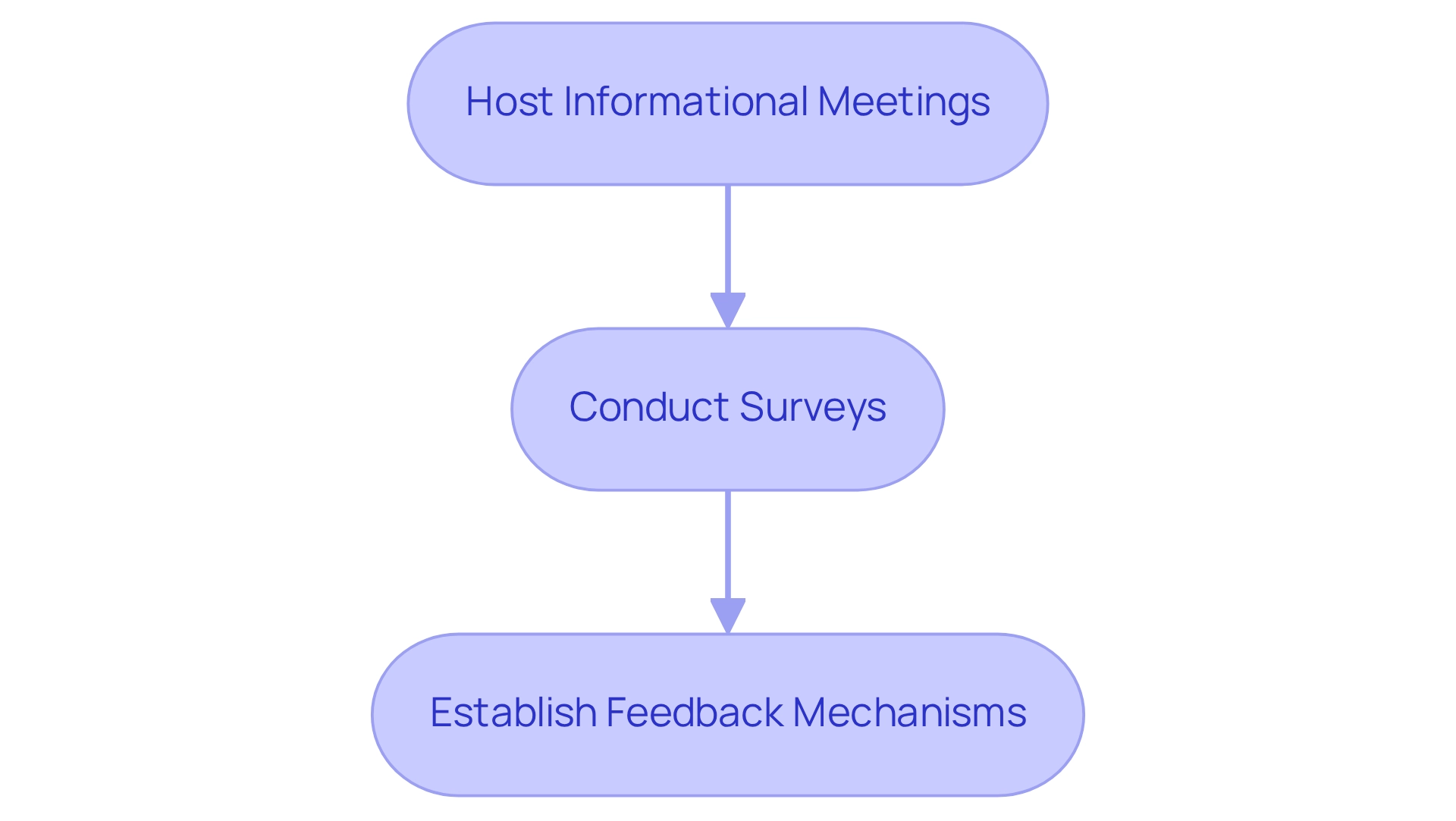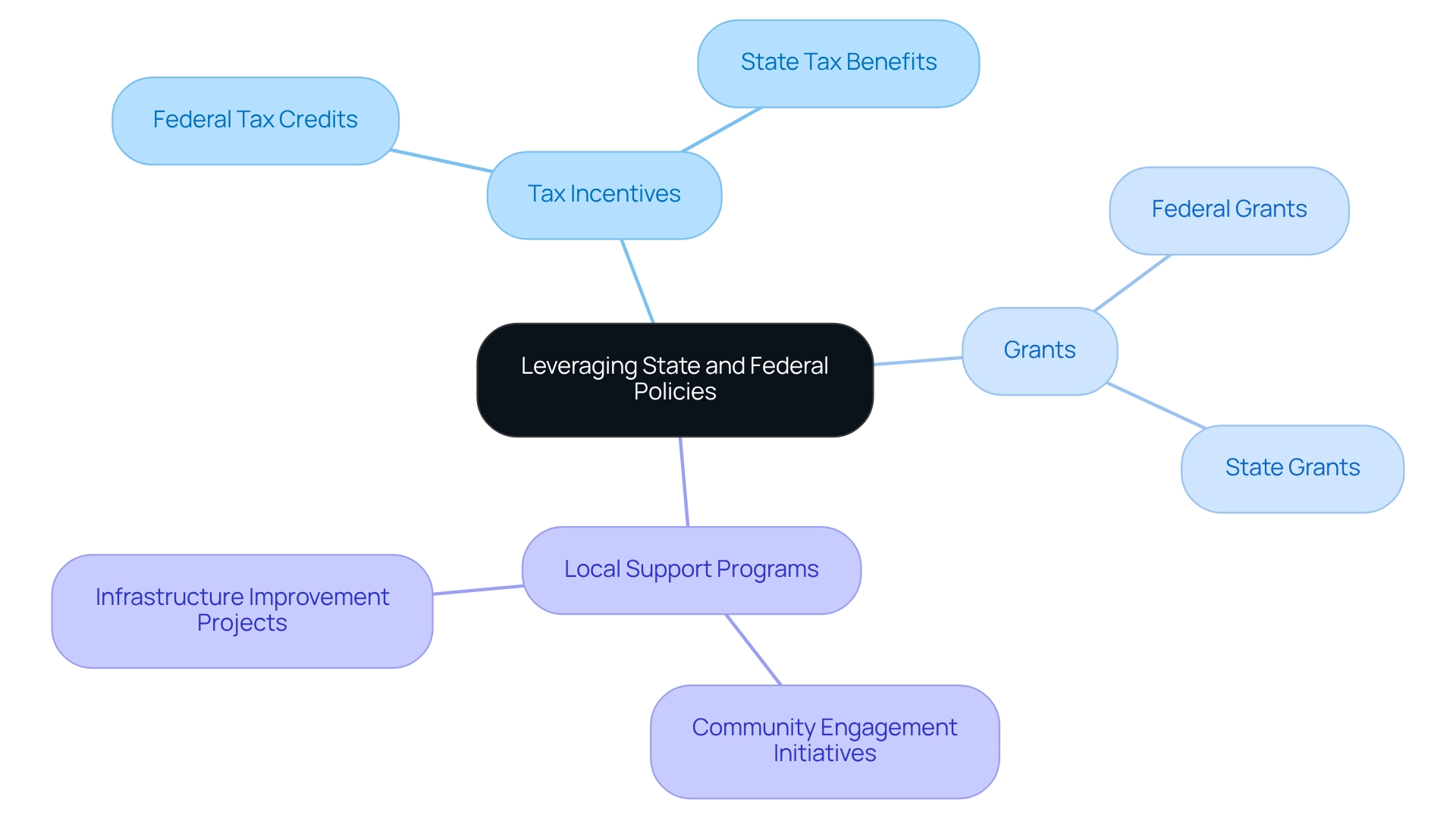Overview
Key strategies for community energy agreements in wind projects encompass:
- The formation of robust coalitions
- Proactive engagement with the community from the outset
- Advocacy for specific, enforceable provisions in agreements
These approaches not only enhance transparency but also build trust and ensure that community concerns are effectively addressed. Ultimately, this leads to more successful and widely accepted wind energy initiatives.
Introduction
In the pursuit of sustainable energy solutions, wind energy projects emerge as a beacon of promise, presenting a multitude of benefits alongside their unique challenges. The success of these initiatives relies not only on the technology and resources involved but also on the crucial role of community engagement.
By forging robust coalitions among local residents, government officials, and industry stakeholders, developers can cultivate a collaborative environment that promotes transparency and ownership. This article explores essential strategies for effective community engagement, emphasizing the significance of:
- Understanding both the benefits and burdens of wind energy
- Incorporating community feedback from the outset
- Advocating for enforceable agreements
- Leveraging state and federal policies to enhance project outcomes
Through these strategies, the pathway to successful wind energy implementation can become clearer and more inclusive.
Form Strong Coalitions for Effective Community Engagement
Building robust coalitions is essential for uniting local residents, government representatives, and industry stakeholders. This cooperative approach not only enhances transparency but also fosters a sense of ownership among group members. Effective coalitions lead to improved communication, the sharing of resources, and a unified front in support of the initiative.
The complexities of land acquisition, including legal and regulatory challenges, can be daunting. However, by leveraging Harbinger Land's expertise in negotiating and acquiring leases and easements, along with our advanced GIS modeling services, we can streamline this process. Involving regional advocacy organizations is crucial; it assists in addressing community issues and amplifies the benefits of wind energy. This collaboration ultimately results in smoother execution and more secure land rights acquisition.
Consider the impact of a well-structured coalition. How might your community benefit from enhanced cooperation? By recognizing these challenges and embracing effective solutions, we can pave the way for a more sustainable future.

Understand Benefits and Burdens of Wind Energy Projects
Wind energy initiatives present significant advantages, including:
- Job creation
- Increased regional tax revenue
- Enhanced energy independence
However, these initiatives also introduce challenges, such as:
- Noise
- Visual impacts
- Potential disruptions to local wildlife
It is imperative for developers to conduct thorough evaluations and transparently share their findings with the public. By presenting information on job creation and economic benefits alongside strategies to mitigate potential challenges, developers can foster trust and garner support for their initiatives.

Include the Community from the Start of Project Planning
Engaging the public from the very beginning is crucial. This involves:
- Hosting informational meetings
- Conducting surveys
- Establishing effective feedback mechanisms
Such an approach empowers local individuals to voice their opinions and actively contribute to the initiative's development. For instance, incorporating public input into design decisions can lead to modifications that enhance community acceptance, such as repositioning turbine locations to minimize visual impacts. By prioritizing public feedback, developers can foster a more favorable environment for securing approval of their projects.

Advocate for Specific, Enforceable Provisions in Agreements
When addressing agreements for the neighborhood, it is crucial to incorporate specific provisions that delineate the developer's commitments, including hiring practices, investment funds, and environmental protections. These provisions must be enforceable to guarantee compliance. For example, a developer might agree to allocate a portion of earnings from the initiative to a local fund dedicated to development projects. By establishing clear expectations, both parties can collaborate effectively towards shared objectives, thereby minimizing the potential for disputes.

Leverage State and Federal Policies for Enhanced Agreements
Developers must recognize the critical importance of state and federal regulations that foster renewable energy initiatives, including tax incentives, grants, and local support programs. By integrating these elements into collective agreements, developers can significantly enhance the overall value of their initiatives.
For instance, leveraging federal tax credits for renewable energy not only provides financial benefits but also allows for the allocation of resources towards local infrastructure improvements. Furthermore, actively engaging with policymakers to advocate for supportive legislation can fortify community ties and bolster the viability of projects.
How can developers effectively navigate these opportunities to maximize their impact?

Conclusion
Community engagement is essential for the success of wind energy projects. Establishing strong coalitions among local residents, government officials, and industry stakeholders fosters transparency and trust. This approach addresses community concerns and facilitates smoother project execution.
It is crucial to understand both the benefits and burdens of wind energy. Developers must clearly communicate the positive impacts, such as job creation and increased tax revenue, while also acknowledging potential challenges. By presenting thorough assessments and mitigation strategies, trust can be built, garnering community support.
Engaging the community from the outset is vital. Incorporating feedback through meetings and surveys allows developers to make necessary adjustments, enhancing local acceptance and ensuring that community voices are heard. This proactive approach creates a favorable environment for project approval.
Advocating for specific, enforceable provisions in agreements demonstrates a commitment to local interests. Clear expectations regarding local hiring and community investments foster collaboration and reduce disputes. Leveraging state and federal policies can further enhance project viability and provide tangible benefits to the community.
In conclusion, prioritizing community engagement is a foundational element in the success of wind energy initiatives. By fostering collaboration and actively involving stakeholders, developers can effectively navigate the complexities of these projects. This ultimately contributes to a sustainable energy future that benefits all involved.
Frequently Asked Questions
Why are robust coalitions important in local initiatives?
Robust coalitions are essential for uniting local residents, government representatives, and industry stakeholders. They enhance transparency and foster a sense of ownership among group members, leading to improved communication, resource sharing, and a unified front in support of the initiative.
What challenges are associated with land acquisition in wind energy projects?
Land acquisition comes with complexities, including legal and regulatory challenges that can be daunting for developers.
How can Harbinger Land assist with land acquisition?
Harbinger Land can streamline the land acquisition process by leveraging its expertise in negotiating and acquiring leases and easements, as well as utilizing advanced GIS modeling services.
What role do regional advocacy organizations play in wind energy initiatives?
Involving regional advocacy organizations is crucial as they help address community issues and amplify the benefits of wind energy, resulting in smoother execution and more secure land rights acquisition.
What are some key benefits of wind energy initiatives?
Key benefits include job creation, increased regional tax revenue, and enhanced energy independence.
What challenges do wind energy initiatives face?
Challenges include noise, visual impacts, and potential disruptions to local wildlife.
How can developers build trust with the public regarding wind energy projects?
Developers can build trust by conducting thorough evaluations, transparently sharing their findings with the public, and presenting information on job creation and economic benefits alongside strategies to mitigate potential challenges.




